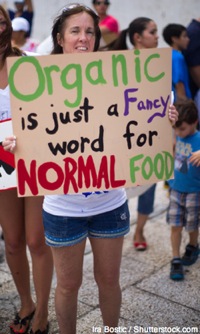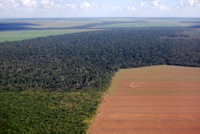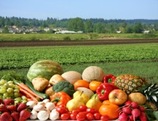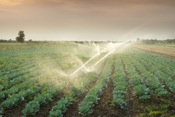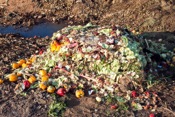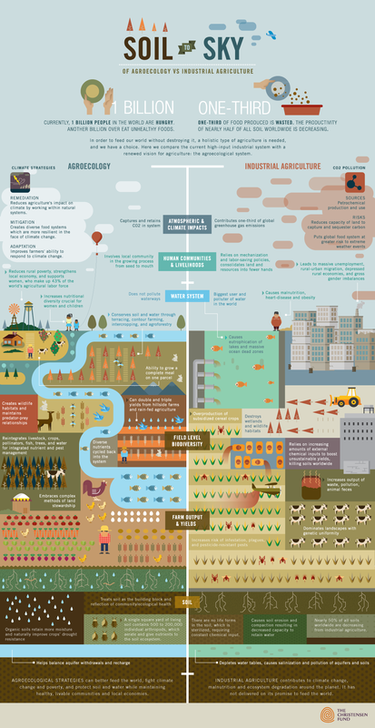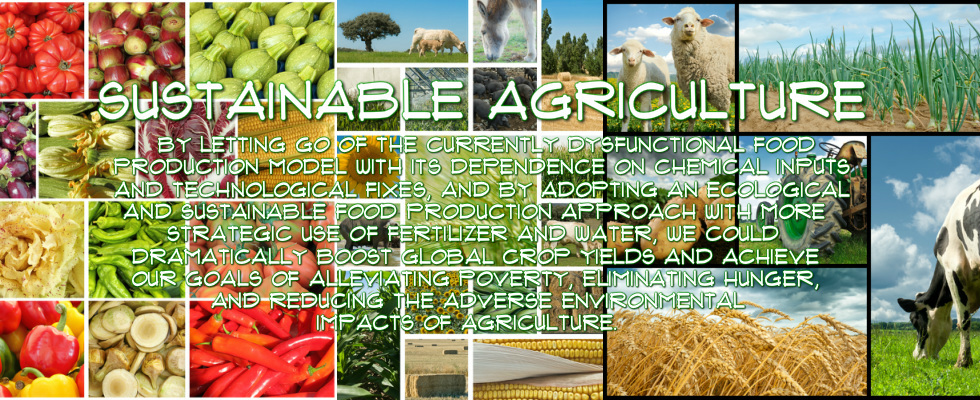
Sustainable Agriculture
The
world is in transition from an era of food abundance to one of scarcity
(see also). With
40% of the planet’s land devoted to human food production, up from 7% in 1700, and as the
world’s demand for food rises 70% by 2050
(see also), feeding a rapidly growing human population can and should be done by
adopting a sustainable food production approach
that can run indefinitely with minimized impacts on the environment, animal welfare and human health. By letting go of the
currently dysfunctional food production model
with its dependence on chemical inputs and technological fixes, and by adopting an
ecological and sustainable food production approach
with
more strategic use of fertilizer and water
(see also), we could dramatically boost global crop yields and achieve our goals of alleviating poverty, eliminating hunger, and reducing the adverse environmental impacts of agriculture.
Climate change
will
reduce crop yields in many countries and after 2030 food, fibre and fuel will compete intensively for limited land and water resources, adding to the difficulty of feeding our growing population. A
comprehensive examination of nearly 300 studies worldwide
shows that organic, small-scale farming
can
feed the world.
Organic farms in developing countries outperformed conventional practices by 57% and organic agriculture could produce enough food, on a per capita basis, to provide 2,640 to 4,380 calories per person per day, which is more than the suggested intake for healthy adults. In conditions of drought,
organic corn yields are 31% higher than non-organic
since organically managed soils trap more carbon in the soil, which allows the soil to hold in more water and nutrients.
According to the study, "With the average yield ratios, we modeled the global food supply that could be grown organically on the current agricultural land base. Model estimates indicate that organic methods could produce enough food on a global per capita basis to sustain the current human population, and potentially an even larger population, without increasing the agricultural land base and while reducing the detrimental environmental impacts of conventional agriculture." A
United Nations Human Rights report,
“Agro-ecology and the right to food,”
is based on an extensive review of recent scientific literature which demonstrates that agroecology, which is
the application of ecology to the design and management of sustainable agroecosystems, if sufficiently supported, can
double food production in entire regions within 10 years
while mitigating climate change and alleviating rural poverty." The
report states, “To feed 9 billion people in 2050, we urgently need to adopt the most efficient farming techniques available. Today’s scientific evidence demonstrates that agroecological methods outperform the use of chemical fertilizers in boosting food production where the hungry live -- especially in unfavorable environments.” Furthermore, according to
the most comprehensive analysis of world agriculture to date, pesticides are
not
necessary to feed the world. For example, Indonesian farmers have
reduced pesticide use on rice fields by 65% and experienced a 15% crop increase. As
PANstates, there are alternatives to relying on pesticides: "There is another way.
Agroecology
is the science behind sustainable farming. This powerful approach combines scientific inquiry with place-based knowledge and experimentation, emphasizing approaches that are knowledge-intensive, low cost, ecologically sound and practical. Home use of pesticides — which on a per acre basis outpaces use on farms by a ratio of 10 to 1 — puts families across the North America at unnecessary risk.
Alternatives are available
to manage home, lawn and garden pests without toxic pesticides." As
Worldwatch Institute states, "A fundamental split has emerged in national and international discussions between embracing an ecological approach to food production and clinging to the currently dysfunctional model with its dependence on chemical inputs and technological fixes. Without radical changes in how we farm, food production will continue to be at odds with the goals of alleviating poverty, eliminating hunger, and restoring natural ecosystems." Moreover, according to a comprehensive, fact-based, balanced two-and-a-half year study by the Independent Pew Commission on industrial farm animal production,
factory farms often pose unacceptable risks to public health, the environment and the welfare of the animals, and recommended that significant changes be implemented immediately.
Ecological Farming - Reducing Hunger and Meeting Environmental Goals
|
Learn more.
Why Sustainable Agriculture?
With human population growing at a rate of approximately
78 million people per year
with
over 7 billion people living on the planet today
and estimates reaching
between 8 and 11 billion by 2050
and
up to 15 billion by 2100, humanity faces perhaps our greatest challenge of keeping fed while keeping a healthy, productive foundation to feed ourselves with.
Current agricultural practices
are amongst the biggest threats to the global environment. Without the development of more sustainable agricultural practices, the planet will become even less able to feed our growing population. Despite the odds,
this can be done: "Feeding the nine billion people anticipated to live on Earth in 2050 without exhausting the Earth's natural resources is possible, provided that we adopt a more sustainable food production approach."
Learn more.
"Let thy food be thy medicine and thy medicine be thy food" ~ Hippocrates
How Much Arable Land Is Left?
"Agriculture is the largest
single cause behind global warming and loss of ecosystem services,
and at the same time the key to human wellbeing in all societies. We now have the opportunity to not only cool the planet, but also to build resilient societies, and improve human wealth." ~
Johan Rockström, Executive Director at Stockholm Resilience Centre at Stockholm University and Stockholm Environment Institute.
International Team of Scientists' Five Point Plan to Feed the World while Protecting the Planet
"Increasing population and consumption are placing unprecedented demands on agriculture and natural resources. Today, approximately a billion people are chronically malnourished while our agricultural systems are concurrently degrading land, water, biodiversity and climate on a global scale. To meet the world’s future food security and sustainability needs, food production must grow substantially while, at the same time, agriculture’s environmental footprint must shrink dramatically. Here we analyse solutions to this dilemma, showing that tremendous progress could be made by halting agricultural expansion, closing ‘yield gaps’ on underperforming lands, increasing cropping efficiency, shifting diets and reducing waste. Together, these strategies could double food production while greatly reducing the environmental impacts of agriculture."
Source:
"Solutions for a cultivated planet," published in Nature, October 20, 2011
"Reduced land clearing for agriculture, particularly in the tropical rainforests, achieved using incentives such as payment for ecosystem services, certification and ecotourism, can yield huge environmental benefits without dramatically cutting into agricultural production or economic well-being."
"Many parts of Africa, Latin America and Eastern Europe have substantial “yield gaps”—places where farmland is not living up to its potential for producing crops. Closing these gaps through improved use of existing crop varieties, better management and improved genetics could increase current food production nearly 60 percent."
"Current use of water, nutrients and ag chemicals suffers from what the research team calls “Goldilocks’ Problem”: too much in some places, too little in others, rarely just right. Strategic reallocation could substantially boost the benefit we get from precious inputs."
"Growing animal feed or biofuels on top croplands, no matter how efficiently, is a drain on human food supply. Dedicating croplands to direct human food production could boost calories produced per person by nearly 50 percent. Even shifting nonfood uses such as animal feed or biofuel production away from prime cropland could make a big difference."
The research team
also recommends:
- Focus on improving agricultural systems where major improvements in food production or environmental protection come with the least expense and effort.
- Pursue approaches that are resilient—that can adapt to the unexpected circumstances that undoubtedly will arise along the way.
- Develop better tools for evaluating costs and benefits of alternatives, so the choices we make clearly move us toward better food security and environmental sustainability.
- Favor the outcome, not the approach. Take the best of conventional agriculture, organic agriculture, industrial farming, small local production, biotechnology and more to create a sustainably intensified global food system.
"For the first time, we have shown that it is possible to both feed a hungry world and protect a threatened planet. It will take serious work. But we can do it."
~Lead AuthorJonathan Foley, head of the University of Minnesota's Institute on the Environment
"If the world is to succeed in overcoming hunger and malnutrition and meeting the demand of today’s and future generations, fundamental changes in the agricultural and food systems are needed. At the recent Rio+20 Summit, world leaders reconfirmed that “poverty eradication, changing unsustainable and promoting sustainable patterns of consumption and production and protecting and managing the natural resource base of economic and social development are the overarching objectives of and essential requirements for sustainable development.” Success in achieving these objectives is literally vital for food security and adequate nutrition for all. This is particularly relevant for the way countries seek to enable their agricultural and food systems to meet the needs of today’s and future generations. It is essential that national governments and all stakeholders promote the gradual realization of the right to adequate food, establish and protect rights to resources, especially for the most vulnerable; incorporate incentives for sustainable consumption and production into food systems; promote fair and well-functioning agricultural and food markets; reduce risk and increase the resilience of the most vulnerable; and invest public resources in essential public goods, including innovation and infrastructure. On the consumption side, there is a need to contribute to sustainable use of resources by reducing over-consumption, shifting to nutritious diets with a lower environmental footprint and reducing food losses and waste throughout the food chain. Regarding food and agricultural production, there is great potential for sustainable intensification. Adequate and stable agricultural productivity growth depends critically on the health of agro-ecosystems and their capacity to provide services such as soil fertility, resistance to pests and diseases and overall resilience of the production system. Healthy ecosystems can also provide important benefits beyond the farm, reducing agricultural pollution that has high costs, and contributing to climate change mitigation, biodiversity conservation and watershed protection." ~ The State of Food Insecurity in the World 2012, FAO
"The future of agriculture and the ability of the world food system to ensure food security for a growing world population are closely tied to improved stewardship of natural resources. Major reforms and investments are needed in all regions to cope with rising scarcity and degradation of land, water and biodiversity and with the added pressures resulting from rising incomes, climate change and energy demands. There is a need to establish the right incentives to harness agriculture’s environmental services to protect watersheds and biodiversity and to ensure food production using sustainable technologies." ~ How to Feed the World in 2050, FAO
A report released by a British engineering society reveals that worldwide, billions of tons of food are wasted each year because of poor agriculture practices, which include inefficient harvesting and inadequate infrastructure and storage - and it's depleting Earth's water supply. Learn more.
According to the Marsden Farm Study, "Increasing Cropping System Diversity Balances Productivity, Profitability and Environmental Health," which has received national attention as a potential model for future farmers, a team of U.S. Department of Agriculture and Iowa State University researchers embarked on a ten year study to compare conventional two year rotations of corn and soy, which is the dominant form of commodity growing, with three and four year rotations that mixed in other grains, alfalfa and livestock to provide manure fertilizer, "The results were stunning: The longer rotations produced better yields of both corn and soy, reduced the need for nitrogen fertilizer and herbicides by up to 88 percent, reduced the amounts of toxins in groundwater 200-fold and didn’t reduce profits by a single cent." Learn more.
Based on a United Nations extensive review of recent scientific literature, the report " Agroecology and the right to food," demonstrates that agroecology, if sufficiently supported, can double food production in entire regions within 10 years while mitigating climate change and alleviating rural poverty. Learn more.
The landmark International Assessment of Agricultural Knowledge, Science and Technology for Development (IAASTD), which is among the most comprehensive and rigorous assessment of agriculture, concluded that “Business as usual is not an option,” highlighting the urgent need for radical shifts in both agricultural policy and corporate behavior. "Acting now to support small-scale producers, family farmers and workers will enable us to create the vibrant, fair and sustainable food systems that the world needs." Learn more.
"Feeding an expanding and more demanding world population in the first half of this century, while attending to the needs of nearly one billion people who are presently undernourished and addressing climate change, will need managed transitions away from “business-as-usual” (BAU) in both conventional and traditional farming. Green agriculture is capable of nourishing a growing and more demanding world population at higher nutritional levels up to 2050. Green agriculture will reduce poverty. Environmental degradation and poverty can be simultaneously addressed by applying green agricultural practices." ~ UNEP Greening the Economy: Agriculture - Investing in Natural Capital, 2011

